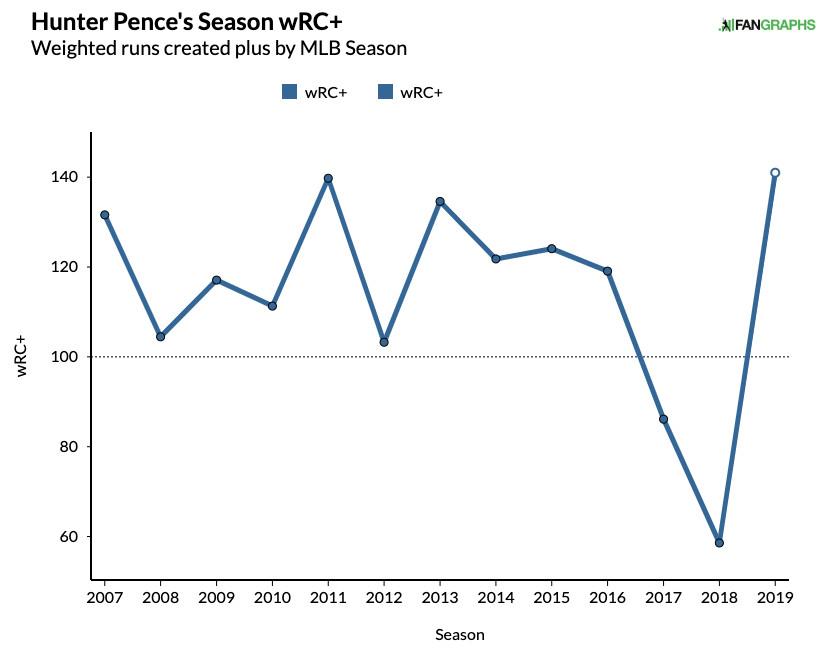Mike Trout is back at the All-Star Game. So are Nolan Arenado and Freddie Freeman and Mookie Betts. But in even greater numbers than expected stars, this year’s Midsummer Classic will host a giant contingent (not a Giant contingent; only one San Francisco player made the team) of new All-Star honorees: Counting injured players and their replacements, 36 of the 75 players on this year’s rosters are first-timers.
Even among those first-timers, some players were rather predictable. It’s no surprise that Matt Chapman is on the AL team after he finished seventh in last year’s MVP vote, or that Ronald Acuña Jr. is on the NL roster after a glorious rookie campaign. Ditto Pete Alonso, whom most Ringer staffers predicted as this year’s NL Rookie of the Year. But Tommy La Stella or James McCann? Some new All-Stars are entirely unexpected.
That classification fits the sport in 2019, as a homer-happy baseball has inflated offense, led to a leaguewide record home run pace, and helped to democratize gains at the plate. As Jeff Sullivan summarized for FanGraphs in 2016 about a trend that has continued through this year, “There’s been a change in distribution. We’re seeing more home runs from what you might label as the lower classes.”
With that pattern in mind, it makes sense to celebrate not only the actual All-Stars, but the most unlikely hitters at every position who have surprised with their impressive first-half performance, whether or not they’ll play in Cleveland on Tuesday. Prospects are exempt from this exercise, as are previous stars (with one exception); we’re looking for players with a purportedly proven track record of mediocrity or worse who have busted through that perception this year. With apologies to Eric Sogard, Gio Urshela, and other runners-up, here are the 2019 Unexpected All-Stars.
Catcher: James McCann, White Sox
Pre-2019: .240/.288/.366; 75 wRC+; -0.1 WAR per 600 plate appearances (roughly a full season’s worth)
In 2019: .316/.371/.502; 133 wRC+; 5.5 WAR/600
For some players, a significant stats boost is the result of legitimate process improvements—better plate discipline, a revamped swing, all the goodies we’ve come to recognize in this era of enhanced player development. Others, though, seem to rely on a far less sustainable way of improving surface stats: Do everything basically the same, and enjoy an unprecedented amount of batted-ball luck.
The good news for McCann is that after a 58 wRC+ season in 2018, the Tigers non-tendered him, and he should do better next winter after signing a one-year, $2.5 million contract with Chicago. The bad news is that he has the second-highest batting average on balls in play this year (minimum 250 plate appearances) at .408 after posting an unremarkable .298 BABIP in his pre-2019 career. That makes for an excellent first half at the plate—McCann has a higher wRC+ than Gary Sánchez, Yasmani Grandal, and J.T. Realmuto—but it doesn’t inspire too much confidence in his ability to sustain it.
First Base: Josh Bell, Pirates
Pre-2019: .260/.348/.436; 110 wRC+; 0.6 WAR/600
In 2019: .302/.376/.648; 156 wRC+; 4.3 WAR/600
Of all the young players on this list, Bell was the best hitter before 2019, but given the positional demands of first basemen, the doesn’t mean much. During Bell’s first three seasons, the average MLB first baseman collected a 112 wRC+, meaning Bell was below average for his position—and his lackluster WAR total reflects this stalled progress from a once well-regarded prospect.
So now, half a season later, Bell serves as another worthy reminder that player development is not linear. Sometimes it starts and stops and starts again—and Bell has started again this year. The first-time All-Star leads the majors in doubles, extra-base hits, and RBI, and ranks in the top five in total bases, home runs (a career-high 27), and OPS. He’s crushed a league-high seven home runs of at least 440 feet and made a friend of the Allegheny River beyond PNC Park’s right-field bleachers. Forget incremental steps from a young player; Bell is zooming right from below-average regular to down-ballot MVP candidate.
Second Base: Tommy La Stella, Angels
Pre-2019: .264/.345/.366; 96 wRC+; 1.2 WAR/600
In 2019: .300/.353/.495; 128 wRC+; 4.2 WAR/600
In five previous MLB seasons, La Stella hit 10 total home runs, and never more than five in a year. So even when he served as an effective utility player and pinch-hitter, he succeeded more as an on-base threat than as a power bat. Enter the 2019 juiced ball; La Stella has 16 homers this season alone, along with the same isolated power mark as Mookie Betts. And the bat control is still there, too: He has the second-lowest strikeout rate among qualified hitters this year, behind only teammate David Fletcher.
La Stella’s breakout hit the pause button last week, when he fouled a pitch off his right leg and fractured his tibia. He’ll miss Tuesday’s All-Star Game, in which he was set to play for the first time, as well as the next 8-to-10 weeks. But for the first half, at least, La Stella served as an improbable poster boy for the leaguewide power surge.
Third Base: Hunter Dozier, Royals
Pre-2019: .228/.279/.388; 78 wRC+; -1.2 WAR/600
In 2019: .282/.367/.532; 133 wRC+; 4.6 WAR/600
Selected eighth overall in the 2013 draft, Dozier never quite fulfilled the promise implied by that slot. His best-ever prospect ranking was 95th by Baseball Prospectus (and he never reached the top 100 from Baseball America or MLB.com), and he didn’t hit much in the minors or his initial MLB stints. But Dozier has checked off just about every statistical box a breakout player looks for this year: He’s struck out less, walked more, hit the ball harder, and generated fewer grounders.
A number of other top-20 picks from 2013 have chosen this year to take a massive step forward at the MLB level: Clint Frazier, Austin Meadows, Dominic Smith, Hunter Renfroe, J.P. Crawford, and Tim Anderson. But none more than Dozier, who looked like a washout just a year ago and is now a real long-term piece in the Royals’ rebuild.
Shortstop: Jorge Polanco, Twins
Pre-2019: .272/.329/.420; 99 wRC+; 1.5 WAR/600
In 2019: .312/.368/.514; 129 wRC+; 4.4 WAR/600
If you want to question the effectiveness of PEDs in baseball, Polanco might be the best starting point for evidence. When he was suspended for the first 80 games of the 2018 season after testing positive for a banned substance, Polanco profiled as a decent but unspectacular shortstop—yet not until this year, presumably PED-free, did he become an offensive force.
Even in the context of the league’s greater offensive tilt, Polanco’s power spike is impressive. He’s cut his ground ball rate to the lowest (tied with Mike Trout) among qualified hitters and added nearly four miles per hour to his average exit velocity this year. He’s a deserving starter in Tuesday’s game, even as shortstops across the majors hit like never before: By wRC+, he’s been better at the plate this year than Javier Báez, Francisco Lindor, and Trevor Story.
Left Field: Mark Canha, Athletics
Pre-2019: .239/.305/.424; 99 wRC+; 1.2 WAR/600
In 2019: .233/.371/.503; 134 wRC+; 4.2 WAR/600
Long a multipositional player for Oakland, Canha has spent at least five games each this year as a first baseman, left fielder, center fielder, right fielder, designated hitter, and pinch-hitter. He fits in the outfield on the Unexpected All-Stars roster because, frankly, there’s much more competition at the infield spots.
Against any point of comparison, though, Canha deserves recognition for his first-half production, particularly as a 30-year-old utility man who’s never qualified for a batting title. Despite some weirdness in his batted-ball results this year—Canha has an incredibly low BABIP, though that’s partly explained by his league-high rate of infield pop-ups—he looks like a better hitter from a process perspective. He’s basically stopped swinging at pitches outside the strike zone, which has nudged his walk rate from 3.7 percent in 2017 to 8.3 percent in 2018 to 15.3 percent in 2019. The latter jump is the largest in the majors since last year.
The sometimes-platoon bat has especially hit better against right-handed pitchers, amassing a .955 OPS against same-handed throwers versus the career .730 OPS he had against them before this season. And in an Athletics lineup that has suffered downturns from Khris Davis and Stephen Piscotty, every hit—and walk—counts.
Center Field: Ketel Marte, Diamondbacks
Pre-2019: .263/.324/.389; 92 wRC+; 1.8 WAR/600
In 2019: .311/.359/.559; 133 wRC+; 5.9 WAR/600
Marte was a useful player before this year: a switch hitter with a near-league-average bat, and a solid defender flexible enough to play multiple up-the-middle positions. In just half a season, though, he’s boosted his output from useful to legitimately star-level. Here are the top five position players in all of baseball by 2019 WAR:
- Mike Trout
- Cody Bellinger
- Christian Yelich
- Ketel Marte
- Alex Bregman
Look at that company! Marte has split his time almost evenly between second base and center field and graded very well in his first exposure to the latter; he’s also crushed a career-high 20 homers, amassed an NL-leading hit total, and—the pattern holds—hit the ball harder and more regularly in the air to maximize his power. The diminutive Diamondback is listed at 165 pounds, yet he tied for the third-longest home run of the first half with this 482-foot blast off Steven Matz in June.
Right Field: Max Kepler, Twins
Pre-2019: .233/.313/.417; 94 wRC+; 1.9 WAR/600
In 2019: .263/.337/.523; 122 wRC+; 4.6 WAR/600
Kepler looks like the outfield version of Bell: a former heralded prospect who hadn’t tapped into that potential in several tries at the MLB level, only to transcend his previous performance this year. In three full seasons before 2019, Kepler had produced remarkably similar batting lines each year: a batting average around .230, an on-base percentage around .315; and a slugging percentage around .420. The league’s offensive environment didn’t matter; Kepler was the same hitter.
This year, though, Kepler rates comfortably above average as he’s hit the ball harder and with more pull power; he’s boosted his pull rate more than any other qualified hitter from last season, and that helps because 61 of Kepler’s 77 career homers have gone to the pull side. His is a similar offensive profile to Brian Dozier’s at the former Twin’s power-hitting peak, and Minnesota fans would be thrilled to find another Dozier for their lineup. Like Bell, Kepler—who is also an excellent defender—already has a new career high in home runs, with 21; like Polanco, he’s a propulsive force atop the lineup for the division-leading Twins—the best unexpected team of the first half.
Designated Hitter: Hunter Pence, Rangers
Pre-2019: .280/.334/.458; 115 wRC+; 2.7 WAR/600
In 2019: .294/.353/.608; 141 wRC+; 4.5 WAR/600
Pence doesn’t fit with the rest of the players on this team. He’s by far the oldest, for one; he’s by far the most accomplished, for another: Before 2019, he made three All-Star teams as a reserve and received MVP votes in four seasons. But his year-by-year wRC+ graph is so magnificent that we can’t in good faith leave him off the Unexpected All-Stars roster.

Pence’s career was done. Cooked. Through. His wRC+ dropped to 86 in 2017, then 59 in 2018, when he hit just four home runs in 248 plate appearances. In fewer trips to the plate this year, he’s already at 15 home runs—and sure, the move from San Francisco to Texas helps, as does the 2019 ball, but those factors explain just a fraction of his success. Pence’s current 141 wRC+ would be his best ever for a season, and he hasn’t delivered an extended offensive stretch this good in a half-decade.
Pence is currently on the IL with a groin strain and thus won’t play in Tuesday’s game, despite being voted as a starter. But from signing a minor league contract this winter to being voted as a deserving All-Star Game starter for the first time, he embodies the spirit of the Unexpected All-Stars. There’s no better player to round out this team.
